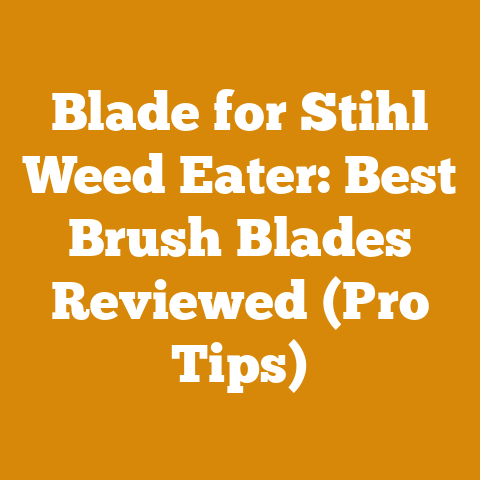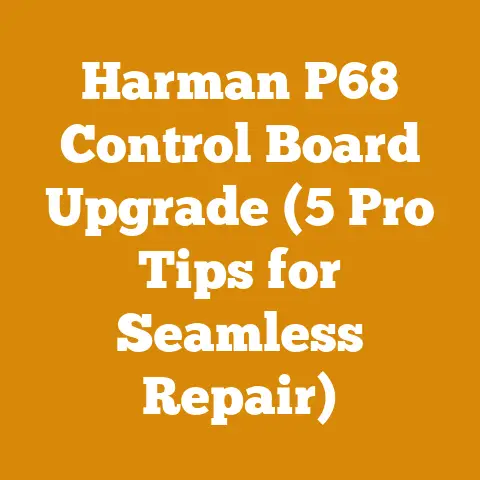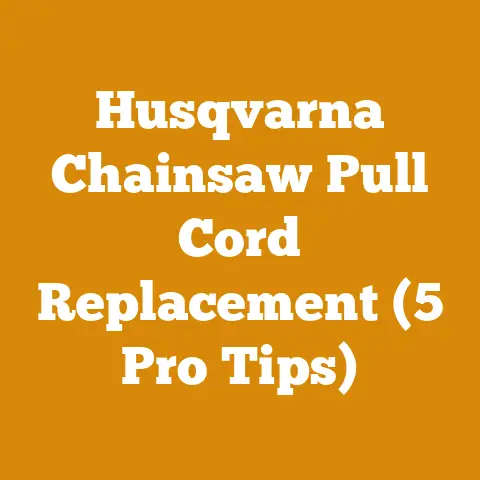Cypress Knees Woodcraft (5 Pro Tips for Perfect Cuts)
“She blinded me with science!” Thomas Dolby’s iconic tune might not be the first thing that pops into your head when you think about cypress knees, but trust me, there’s a surprising amount of science – and a healthy dose of art – involved in transforming these unique formations into stunning woodcraft. I’ve spent years wrestling with cypress knees, turning them from oddities into statement pieces, and I’ve learned a thing or two about getting perfect cuts. Forget just hacking away; this guide is about precision, safety, and unlocking the hidden beauty within each knee. So, grab your safety glasses, fire up your chainsaw, and let’s dive into the art and science of cypress knee woodcraft.
Cypress Knees Woodcraft: 5 Pro Tips for Perfect Cuts
Cypress knees. They’re those peculiar woody growths that pop up around bald cypress trees (Taxodium distichum), particularly in swampy areas. They’re like nature’s sculptures, each one uniquely shaped and full of character. But turning these gnarled forms into something beautiful and functional takes skill, patience, and the right techniques. These tips will help you avoid common pitfalls and achieve professional-quality results.
1. Understanding Your Cypress Knee: The Foundation of a Flawless Cut
Before you even think about firing up your chainsaw, you need to know your knee. This isn’t just about aesthetics; it’s about understanding the wood’s internal structure, potential weaknesses, and how it will react to your cuts.
- Visual Inspection is Key: I always start with a thorough 360-degree inspection. Look for cracks, rot, insect damage, or any other imperfections. These flaws will dictate where you can safely and effectively cut. Remember, cypress, while naturally rot-resistant, isn’t immune to everything.
- Moisture Content Matters: Freshly harvested cypress knees are soaked. The ideal moisture content for woodworking is generally between 6-12%. Cutting wet wood can lead to warping, cracking, and uneven finishes. I use a moisture meter religiously.
- Data Point: Green cypress can have a moisture content exceeding 100% (dry weight basis). Attempting to work with wood at this level is a recipe for disaster.
- Drying Times: Air-drying cypress can take months, even years, depending on the thickness and climate. Kiln-drying is faster, but requires careful control to prevent checking (surface cracks). I once ruined a beautiful knee by rushing the drying process in a makeshift kiln. Lesson learned!
- Grain Orientation: Cypress knees often have wildly varying grain patterns. Understanding how the grain runs will help you predict how the wood will split or react to carving. Look for areas where the grain changes direction abruptly; these can be weak points.
- Size and Shape Considerations: The size and shape of the knee will significantly influence your project possibilities. A small, relatively straight knee might be perfect for a small decorative piece, while a larger, more convoluted knee could be transformed into a unique table base.
- Data Point: Cypress knees can range in size from a few inches to several feet in height and diameter. Larger knees obviously require more powerful saws and careful handling.
- Personal Story: I recall one project where I completely misjudged the internal structure of a knee. I made a cut based purely on the external appearance, only to discover a large, hidden void inside. The project was salvaged, but it taught me the importance of meticulous inspection.
Specification Table: Cypress Knee Assessment Checklist
| Feature | Description | Action |
|---|---|---|
| Moisture Content | Percentage of water in the wood. | Measure with a moisture meter. Air dry or kiln dry to 6-12% for woodworking. |
| Cracks/Checks | Visible splits or fissures in the wood. | Assess severity. Minor cracks can be stabilized with epoxy. Major cracks may render the knee unusable or require significant repair. |
| Rot/Decay | Soft, spongy areas indicating fungal degradation. | Probe with a sharp tool. Remove any decayed wood. Treat with a wood preservative. Severe rot indicates the knee is unsuitable for most projects. |
| Insect Damage | Holes or tunnels indicating insect infestation. | Inspect for active infestations. Treat with an insecticide if necessary. Fill holes with epoxy. |
| Grain Orientation | Direction and pattern of the wood fibers. | Observe the surface grain. Consider how the grain will affect cutting and carving. Plan cuts to minimize tear-out and maximize strength. |
| Size/Shape | Dimensions and overall form of the knee. | Measure height, width, and diameter. Visualize potential projects. Select knees that are appropriately sized and shaped for your intended use. |
| Weight | Mass of the knee. | Estimate or weigh the knee. Consider the weight when planning handling and transportation. |
| Species | Bald Cypress (Taxodium distichum) | Verify the species to understand its properties. |
| Color | Natural color of the wood. | Note the color for aesthetic considerations and potential staining. |
| Knots | Hard, circular areas where branches once grew. | Evaluate the size, location, and stability of knots. Knots can add character but also create challenges during cutting and carving. |
2. Chainsaw Selection and Calibration: Precision Starts with the Right Tool
Your chainsaw is your primary tool for shaping cypress knees. Choosing the right saw and ensuring it’s properly calibrated are crucial for achieving clean, accurate cuts. I’ve seen too many projects ruined by using the wrong saw or a poorly maintained one.
- Saw Size and Power: For smaller knees (less than 12 inches in diameter), a smaller chainsaw (14-16 inch bar) might suffice. However, for larger knees, I recommend a more powerful saw with an 18-20 inch bar. Don’t underestimate the density of cypress; you’ll need the extra power.
- Data Point: A chainsaw with a 50cc engine or larger is generally recommended for cutting hardwoods and larger pieces of cypress.
- Chain Type Matters: A ripping chain is designed specifically for cutting with the grain, producing smoother, more efficient cuts. A crosscut chain is better suited for cutting across the grain. For cypress knees, which often involve both types of cuts, I prefer a ripping chain for its overall versatility.
- Chain Sharpness is Non-Negotiable: A dull chain is not only inefficient but also dangerous. It can cause the saw to kick back, bind, or overheat. I sharpen my chains regularly, usually after every hour of use.
- Technical Requirement: The raker depth (the height difference between the cutting teeth and the rakers) should be maintained according to the manufacturer’s specifications. Incorrect raker depth can significantly reduce cutting performance and increase the risk of kickback.
- Saw Calibration: Ensure your carburetor is properly adjusted for optimal performance. A poorly calibrated carburetor can lead to a lean or rich fuel mixture, affecting power, fuel efficiency, and engine longevity.
- Practical Tip: I use a tachometer to accurately adjust the carburetor’s high and low idle speeds. This ensures the saw is running at its peak performance without over-revving.
- Safety Features: Always ensure your chainsaw is equipped with functioning safety features, including a chain brake, throttle lock, and handguards.
- Safety Code: Adhere to all local and national safety regulations regarding chainsaw use. Always wear appropriate personal protective equipment (PPE), including safety glasses, hearing protection, gloves, and chainsaw chaps.
Specification Table: Chainsaw Calibration Standards
| Parameter | Specification | Measurement Tool | Adjustment Procedure |
|---|---|---|---|
| Idle Speed | Manufacturer’s Recommendation (RPM) | Tachometer | Locate the idle speed adjustment screw on the carburetor. Turn the screw clockwise to increase idle speed and counterclockwise to decrease idle speed. Adjust until the engine idles smoothly without stalling. |
| High Speed | Manufacturer’s Recommendation (RPM) | Tachometer | Locate the high-speed adjustment screw on the carburetor. Make small adjustments while the engine is running at full throttle. Monitor the engine speed with a tachometer. Adjust until the engine reaches the manufacturer’s recommended maximum RPM without exceeding it. |
| Chain Tension | Snug, but with slight sag on the underside. | N/A | Loosen the bar nuts on the chainsaw. Use the chain tensioning screw to adjust the tension of the chain. The chain should be snug against the bar but still able to be pulled around by hand. Tighten the bar nuts securely. |
| Chain Sharpness | Sharp, with consistent cutting angle. | Visual Inspection | Inspect the cutting teeth for sharpness. Use a chainsaw file to sharpen the teeth, maintaining the correct cutting angle and depth. Ensure all teeth are sharpened evenly. |
| Raker Depth | Manufacturer’s Specification (inches/mm) | Depth Gauge | Use a raker depth gauge to measure the height of the rakers relative to the cutting teeth. File down the rakers if they are too high, following the manufacturer’s instructions. |
| Fuel Mixture | Manufacturer’s Recommendation (ratio of oil to gasoline) | Measuring Container | Mix the correct ratio of oil and gasoline according to the manufacturer’s instructions. Use a measuring container to ensure accurate proportions. |
| Air Filter | Clean and free of debris. | Visual Inspection | Inspect the air filter for dirt and debris. Clean or replace the air filter as needed. |
| Spark Plug | Clean and properly gapped. | Spark Plug Gauge | Inspect the spark plug for fouling or damage. Clean or replace the spark plug as needed. Use a spark plug gauge to ensure the correct gap. |
| Bar Lubrication | Adequate oil flow to the chain. | Visual Inspection | Check the oil level in the chainsaw’s oil reservoir. Ensure that oil is flowing freely to the chain. Clean the oiler port if it is clogged. |
3. The Art of the First Cut: Planning and Precision
The first cut is often the most critical. It sets the stage for the rest of the project and can significantly impact the final outcome.
- Visualize the Final Shape: Before making any cuts, I spend time visualizing the final shape I want to achieve. This helps me determine the best angle and location for the initial cut. I sometimes even sketch out the proposed shape on the knee itself using chalk.
- Safety First: Ensure you have a stable and secure base for the knee. Use wedges or supports to prevent it from rolling or shifting during the cut.
- Strategic Cuts: Consider the grain orientation and any existing imperfections when planning your first cut. Aim to remove any unwanted material while minimizing waste.
- Plunge Cutting: In some cases, a plunge cut (inserting the saw directly into the wood) may be necessary. This requires careful control and a sharp chain. Always use the chain brake when repositioning the saw.
- Test Cuts: If you’re unsure about a particular cut, make a small test cut in an inconspicuous area first. This allows you to assess the wood’s reaction and adjust your technique accordingly.
4. Mastering Freehand Carving Techniques: Unleash Your Creativity
Cypress knees often lend themselves to freehand carving, allowing you to create unique and organic shapes. This requires a steady hand, a good eye, and a willingness to experiment.
- Start Slow and Steady: Don’t try to remove too much material at once. Take small, controlled cuts, gradually shaping the knee to your desired form.
- Use the Tip of the Bar: The tip of the chainsaw bar is ideal for detail work and creating intricate shapes. Be careful to avoid kickback when using the tip of the bar.
- Vary Your Cuts: Experiment with different cutting angles and techniques to create texture and visual interest.
- Embrace Imperfections: Cypress knees are naturally imperfect. Embrace these imperfections and incorporate them into your design. They can add character and uniqueness to your finished piece.
- Case Study: I once worked on a project where I transformed a cypress knee into a whimsical birdhouse. I used freehand carving to create intricate details, such as a small arched doorway and a series of decorative perches. The client was thrilled with the result, and it became a focal point in their garden.
5. Finishing Touches: Bringing Out the Beauty
Once you’ve shaped the cypress knee to your liking, it’s time to focus on the finishing touches. This involves sanding, sealing, and applying a protective finish.
- Sanding is Essential: Start with a coarse grit sandpaper (80-grit) to remove any rough edges or saw marks. Gradually work your way up to finer grits (120-grit, 220-grit) to achieve a smooth, even surface.
- Dust Removal: Thoroughly remove all sanding dust before applying any finish. I use a vacuum cleaner and a tack cloth to ensure a clean surface.
- Sealing the Wood: Applying a sealer helps to prevent moisture absorption and provides a uniform base for the finish. I prefer a penetrating oil-based sealer for cypress.
- Choosing the Right Finish: The choice of finish depends on the intended use of the cypress knee. For indoor projects, a varnish or lacquer provides a durable and attractive finish. For outdoor projects, a spar varnish or marine-grade sealant is recommended.
- Material Specifications: Select a finish that is specifically designed for exterior use and contains UV inhibitors to protect the wood from sun damage.
- Multiple Coats: Apply multiple thin coats of finish, allowing each coat to dry completely before applying the next. This will create a more durable and long-lasting finish.
- Maintenance: Regularly inspect the finish and reapply as needed to protect the wood from the elements.
Specification Table: Finishing Material Requirements
| Material | Specification | Application Method | Drying Time (per coat) | Purpose |
|---|---|---|---|---|
| Sandpaper | Various grits (80-grit to 220-grit) | Hand/Sanding Block | N/A | Smoothing the surface of the wood. |
| Wood Sealer | Penetrating oil-based sealer | Brush/Cloth | 24 hours | Preventing moisture absorption and providing a uniform base for the finish. |
| Varnish (Indoor) | Polyurethane varnish | Brush/Spray | 24 hours | Providing a durable and attractive finish for indoor projects. |
| Spar Varnish (Outdoor) | Marine-grade spar varnish | Brush/Spray | 24 hours | Providing a durable and weather-resistant finish for outdoor projects. |
| UV Inhibitor | Stabilizes finish | Mixed into Finish | 24 hours | Added to finish to protect the wood from sun damage. |
| Tack Cloth | Sticky cloth for dust removal | Hand | N/A | Removing dust particles from the wood surface before applying the finish. |
| Mineral Spirits | Solvent for thinning oil-based finishes and cleaning brushes | Cloth/Container | N/A | Thinning oil-based finishes to improve flow and leveling. Cleaning brushes and equipment after use. |
| Gloves | Nitrile gloves | Hand | N/A | Protecting hands from chemicals and finishes. |
| Respirator | NIOSH-approved respirator | Face | N/A | Protecting lungs from harmful vapors and dust. |
Final Thoughts
Working with cypress knees is a rewarding experience. It’s a chance to connect with nature, unleash your creativity, and create something truly unique. By following these pro tips, you can avoid common mistakes, achieve professional-quality results, and transform these fascinating formations into stunning works of art. Remember to always prioritize safety, take your time, and embrace the imperfections. The beauty of cypress knee woodcraft lies in its natural character and individuality. So, go forth and create!
Important Disclaimer: This guide provides general information and best practices for cypress knee woodcraft. Always consult with experienced professionals and adhere to all local and national safety regulations. The author and publisher are not responsible for any injuries or damages resulting from the use of this information.






